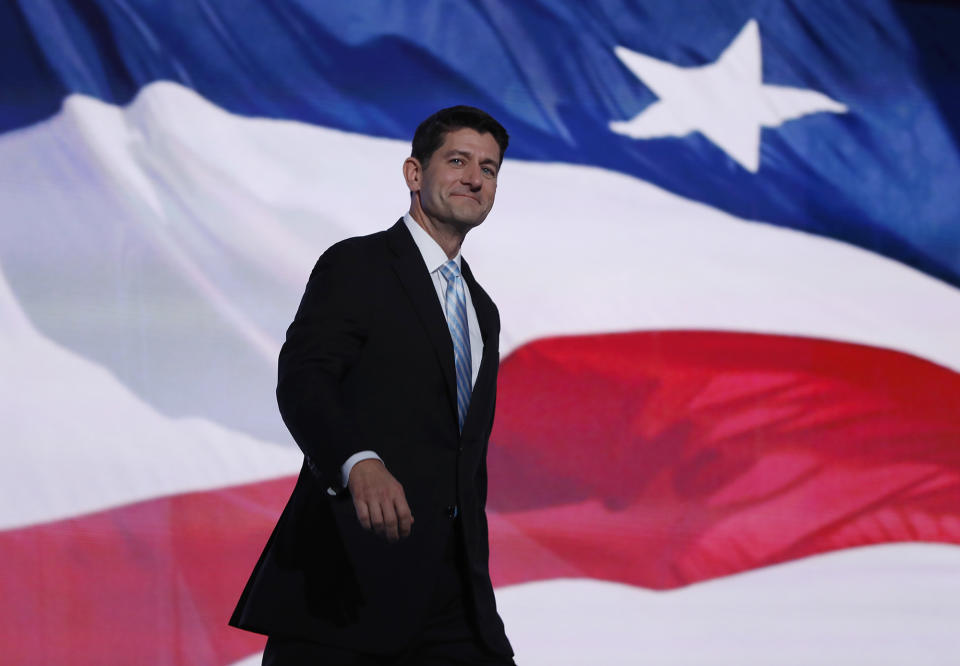Down Ticket #1: How Trump could cost the GOP its biggest House majority since WWII

Forget Clinton. Forget Trump. Introducing Down Ticket: Yahoo News’ complete guide to this year’s most fascinating House, Senate and governors’ races. Coming to you every Tuesday and Thursday until Nov. 8. What you need to know today.
_____
Paul Ryan and the rest of the GOP are starting to stress about losing the House. Why they’re right to worry.
Paul Ryan should be worried about losing his job.
Not his job, mind you, as a congressman, although Ryan is competing in a primary today. Sure, Ryan’s “contest” against challenger Paul Nehlen — an anti-free-trade, anti-Muslim Donald Trump mini-me — has attracted a lot of attention in recent weeks, in part because Sarah Palin has endorsed Nehlen and Trump initially threatened to do the same.
“Paul Ryan Stares Down GOP Revolt in His Backyard,” the Washington Post reported.
“Paul Ryan Can’t Win,” declared Vanity Fair.
And yet — media hype aside — Paul Ryan will win Tuesday’s primary. Ryan has represented Wisconsin’s First Congressional District since 1999. Nehlen is the vice president of a water-filtration company. Nehlen has $175,000 in his campaign coffers. Ryan has nearly $10 million. Eighty percent of Janesville-area voters have a favorable opinion of Ryan; only 14 percent see him unfavorably. Nehlen’s numbers are reversed: 16 percent favorable, 47 percent unfavorable. The latest poll shows Ryan with 80 percent of the vote. Nehlen trails by 66 points.
So again: Paul Ryan isn’t worried about losing his job as a congressman. He may, however, be starting to worry about the GOP losing its largest majority in the House of Representatives since World War II — which would, in turn, cost him his other, more exalted gig: speaker of the House.
In public, Ryan has been coy about the possibility, saying only that anyone in his shoes would be concerned. “Mitt [Romney] and I lost by four points and we lost eight seats. [John McCain] lost by seven [in 2008] and we lost 21 seats,” he recently told the Washington Post. “If you’re speaker of the House, it’s your job to worry about the Republican majority, no matter what the circumstances are.”
But in private, Ryan is beginning to sound anxious. Why? Because of Donald Trump. According to the New York Times, “Ryan expressed concerns that the House was increasingly at risk” during a closed-door meeting with donors last week, imploring them “not to assume that the House was impregnable and not to focus their efforts entirely on retaining the Senate.”

This isn’t just a fundraising scare tactic — or at least it shouldn’t be. Ryan has reason to worry.
It’s hard to overstate how extraordinary a Democratic takeover of the House would be. Every cycle, Nancy Pelosi talks a good game about how her party is finally going to win back the lower chamber of Congress. She never actually believes it.
Aside from one brief interregnum — early 2007 to late 2010 — Republicans have ruled the House for the last two decades. Republican-dominated redistricting — redrawing the congressional boundaries to give the incumbent party a leg up — has only strengthened their hold. So have midterm voting patterns: Republicans tend to turn out; Democrats don’t. Democratic voters are increasingly concentrated in fewer and fewer districts, a huge disadvantage. Wave elections — the sort that can flip Congress — rarely take place in presidential years. And it’s challenging enough for any party to win three consecutive terms in the Oval Office. The only time it has happened in the modern era — 1988 — the composition of Congress barely changed at all.
But despite all that, Pelosi & Co. now have a real shot at returning to power next January.
There was always a risk of Republicans losing the Senate in 2016. The entire map is tilted against them. Democrats are defending 10 seats this year; Republicans are defending 24. If as few as four of those seats flip — a likely outcome — the GOP’s majority is gone.
Democrats don’t have the same sort of structural advantage in the House, though. For one thing, House Republicans enjoy a much bigger cushion — 247 seats to the Democrats’ 186 — than their Senate counterparts. This means that Pelosi would need a net gain of at least 30 seats to recapture control — the kind of swing that gerrymandering largely rules out. In a normal election year, they wouldn’t stand a chance.
But as you may have noticed, 2016 is not a normal election year.
Which explains why Ryan seems a little stressed. The worse Trump does on a national level — the more he tarnishes the GOP’s image with the sort of shenanigans that consumed last week’s campaign coverage — the worse down-ballot Republicans will do. It’s a simple matter of turnout. Presidential races drive voters to the polls; Republicans who aren’t inspired to vote for Trump will be less inclined to show up and vote, period — and district by district, the GOP’s congressional candidates will likely suffer. (Split-ticket voting has also declined over the last generation, as polarization has increased.)
The last time the nonpartisan analysts at the Cook Political Report published their trademark “race ratings” was July 22 — the day after the GOP concluded its convention in Cleveland and right before Trump hit his high-water mark in the polls. But even then, Cook painted a scary picture for the GOP: one Democratic seat was deemed likely to go Republican, and three more were tossups. The number of Republican tossups, however, was much larger: 17. Another three GOP seats, meanwhile, were leaning Democratic and two more were likely to flip. All told, 45 Republican seats were considered competitive — and 22 had at least a 50/50 chance of going Democratic.
Since then, things have only gotten worse. Trump’s national numbers have cratered. On July 26, he led Clinton 45.7 percent to 44.6 percent in the RealClear Politics polling average; he now trails by 7.2 percentage points. Trump is also losing to Clinton by more than 10 points in at least two key battleground states: New Hampshire and Pennsylvania. As a result, his odds of winning in November have plummeted from 50.1 percent to 13.7 percent, according to FiveThirtyEight, while Clinton’s have climbed to 86.3 percent.
If this persists, Trump will almost certainly be a drag on the rest of Republican ticket. Democrats already lead Republicans on the generic “Which party’s congressional candidate will you vote for?” question by an average of 7.6 percentage points — nearly enough, according to the statisticians, to propel them to a majority in the House. That gap may widen. Down-ticket Republicans may continue to run away from Trump. Race ratings may drift leftward. “Likely Republican” may become “lean Republican.” “Lean Republican” may become “tossup.” “Tossup” may become “lean Democratic.”
And 30 seats suddenly won’t seem so crazy anymore.
_____
Video: Paul Nehlen on his primary contest with Paul Ryan — and his controversial views on Muslims
Yahoo News Guest Anchor Stephanie Sy spoke to Wisconsin businessman Paul Nehlen — who is challenging House Speaker Paul Ryan in the Badger State’s Aug. 9 congressional primaries — about Donald Trump’s belated endorsement of Ryan and whether he thinks he can win despite trailing his opponent by massive margins in the polls.
_____
The races to watch
![(Photos: erickson4us.com, John Howe for Congress via Facebook, Elizabeth Nida Obert/Rochester Post-Bulletin via AP [2], Kristopher Radder/Brattleboro Reformer via AP, Toby Talbot/AP, David Gram/AP, Kristopher Radder/Brattleboro Reformer via AP, MikeforWI via Twitter, Friends of Terry McNulty via Facebook, Lasee for Congress via Facebook, AP)](https://s.yimg.com/ny/api/res/1.2/OWT7TKEcchiL3SoyK6CtUw--/YXBwaWQ9aGlnaGxhbmRlcjt3PTk2MDtoPTYwNA--/https://media.zenfs.com/en/homerun/feed_manager_auto_publish_494/8ff18cde76690a0b716b18b62662ea92)
The Ryan-Nehlen matchup isn’t the only important primary taking place Tuesday. Here are three others to pay attention to:
Minnesota’s Second Congressional District: Republican incumbent John Kline’s decision to retire after 14 years in the House has triggered a fierce battle for control of this swing district south of the Twin Cities. Four Republicans will face off Tuesday for the chance to challenge Democrat Angie Craig, who has been stumping and stockpiling money for months: former conservative radio talk show host Jason Lewis; businesswomen Darlene Miller; state senator and former Red Wing Mayor John Howe; and sales consultant Matt Erickson. Miller has Kline’s endorsement; the NRA backs Howe. But the edge may go to the Lewis, who has the highest name recognition and the backing of the state GOP. Who will win in November, however, is anyone’s guess.
Wisconsin’s Eighth Congressional District: A similar dynamic is at play in this Green Bay swing district: incumbent Reid Ribble is retiring and multiple Republicans are vying to replace him. The field includes state Sen. Frank Lasee of De Pere; Terry McNulty, a Forestville surveyor; and Mike Gallagher of Green Bay. Gallagher, who served as national security adviser for Gov. Scott Walker’s short-lived presidential campaign, had a huge money advantage, raising more than $1 million since the start of 2016 — three times as much as Lasee and 160 times as much as McNulty. Over the last four decades, an equal number of Democrats and Republicans have represented the eighth district in Congress, so Democrats are hopeful that their nominee, Outagamie County executive and a former state representative Tom Nelson, can defeat whomever Republicans choose Tuesday.
Vermont governor: Home to Bernie Sanders, the Green Mountain State is typically considered one of the most liberal corners of the country. But many analysts are calling this year’s gubernatorial contest a tossup. Incumbent Democrat Peter Shumlin is retiring, and on Tuesday, five Democrats and two Republicans will compete for their party’s nominations. On the Democratic side, late stumbles by former Google executive Matt Dunne may give former Transportation Secretary Sue Minter a slight edge; on the GOP side, popular Lt. Gov. Phil Scott is favored over retired Wall Street executive Bruce Lisman, though the race may have tightened in recent days thanks to Lisman’s late $2 million negative ad buy. Oh, and speaking of Sanders, Bernie endorsed 18 candidates for Vermont state office last week. None of them were running for governor.
_____
By the numbers
Stat of the day, via @JakeSherman: "11 percent — six of 54 — of Senate Republicans have said they will not support their party's nominee."
— Ryan Lizza (@RyanLizza) August 9, 2016
… including the latest GOP defector, Maine Sen. Susan Collins, who said Monday that “Trump lacks the temperament, self-discipline and judgment required to be president.”
_____

The best of the rest
Swinging the Senate blue may hinge on Latino voters https://t.co/cTOEq6a71n
— Salon (@Salon) August 9, 2016
https://t.co/1Kv1hg52FJ how true this story was and is. Trump is becoming a big drag on the ticket.
— (((Harry Enten))) (@ForecasterEnten) August 8, 2016
The Nevada Senate race seems to be Harry Reid vs. Donald Trump. It's annoying. And it's only August. My @rgj column: https://t.co/IStcOpKrlD
— Jon Ralston (@RalstonReports) August 7, 2016
Ted Cruz's critics are urging a primary challenger https://t.co/AfDedvf6my via @mkraju & @teddyschleifer pic.twitter.com/rk2OVxh4ya
— CNN Politics (@CNNPolitics) August 9, 2016
Some donors wrapped up in embattled Silicon Valley congressman’s ethics complaint are helping him fight it #CA17 https://t.co/qHoachG2ig
— Sarah D. Wire (@sarahdwire) August 9, 2016
Rubio: No Abortions For Zika-Infected Women https://t.co/DC8RA94Y4E pic.twitter.com/3xc2m6FtsO
— The Daily Caller (@DailyCaller) August 8, 2016
What other R Senators up for re-election might tilt? In tight Senate race, Toomey teetering in support of Trump https://t.co/KGnzffYLoq
— Josh Busby (@busbyj2) August 9, 2016
_____
Countdown
_____



